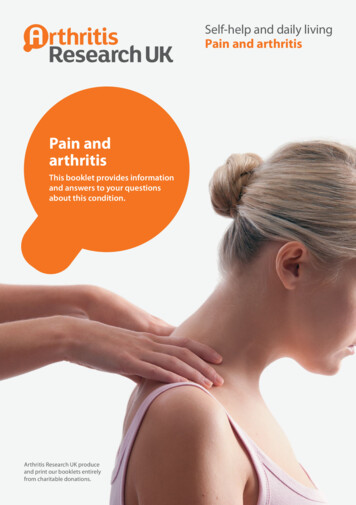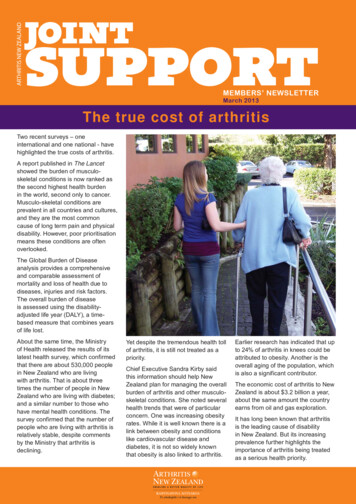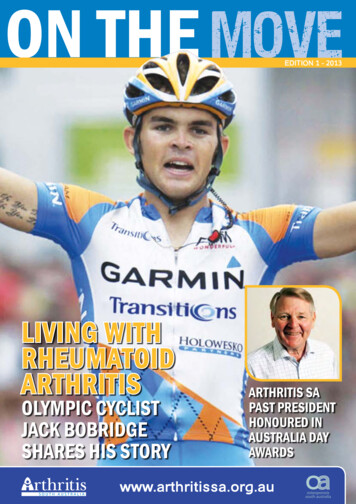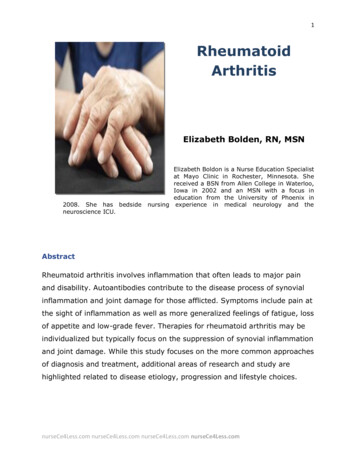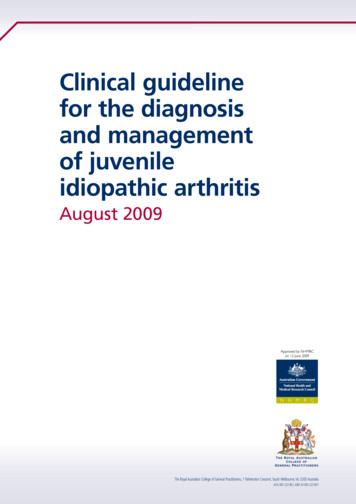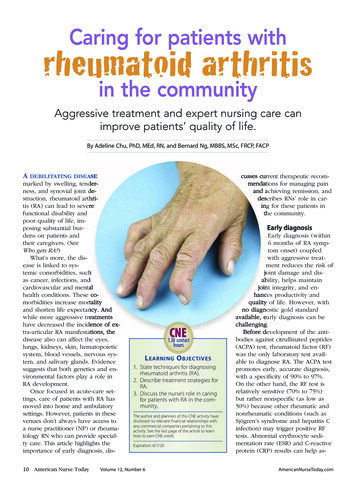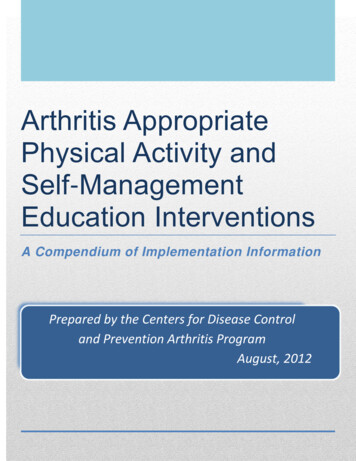
Transcription
Arthritis AppropriatePhysical Activity andSelf-ManagementEducation InterventionsA Compendium of Implementation InformationPrepared by the Centers for Disease Controland Prevention Arthritis ProgramAugust, 2012[Type text][Type text][Type text]
1Compendium of Arthritis Appropriate Interventions – CDC – August, 2012
IntroductionThere currently are a number of arthritis appropriate interventions available and it may be challenging to decidewhich ones are a good fit for your community or organization. The purpose of this compendium is to assist youin selecting interventions by providing a concise, standardized review of each intervention. The Centers forDisease Control and Prevention (CDC) Arthritis Program reviews interventions on the basis of their respectivearthritis appropriateness, adequacy of their evidence-based effectiveness and readiness for implementation asa public health intervention.1 This compendium includes 13 arthritis appropriate interventions for which CDCcurrently funds dissemination; most meet these criteria fully and a few are considered promising programsbecause the systems to support their implementation are still being developed. The most current status of eachintervention is available on the CDC Arthritis Program Web site Intervention reviews are sorted by their focus on physical activity or self-management education and presentedin alphabetical order. Information is organized by the following four headings: program description, programrequirements, contact information, and evidence-based effectiveness. Available Web sites and organizationcontacts can be found under the contact information heading.The interventions reviewed herein include the following:Physical Activity:Arthritis Foundation Exercise Program (AFEP)Active Living Every Day (ALED)Enhance Fitness (EF)Fitness and Exercise Program for People with Arthritis (FEPA) – Promising ProgramFit and Strong! (F&S)Walk with Ease (WWE – Group)Walk with Ease (WWE - Self Directed) – Promising Program1Brady TJ, Jernick S, Hootman J, Sniezek JE. Public health interventions for arthritis: expanding the toolbox of evidence-basedinterventions, Journal of Women’s Health. 2009:18(12)2Compendium of Arthritis Appropriate Interventions – CDC – August, 2012
Arthritis Foundation Aquatics Program (AFAP)**Note: This program meets the CDC Arthritis Program criteria. However, CDC does not fund dissemination ofAFAP because significant market penetration has been achieved.Self-Management Education:Arthritis Self-Management Program (ASMP)The Arthritis Toolkit (Spanish: Manejando Mi Artritis) – Promising ProgramBetter Choices, Better Health for Arthritis (ASMP Internet-Based) – Promising ProgramChronic Disease Self-Management Program (CDSMP)Programa de Manejo Personal la Artritis (ASMP – Spanish)Tomando Control de su Salud (CDSMP – Spanish)Additional interventions will be reviewed by the CDC Arthritis Program as they become available.Four programs being considered for CDC Arthritis Program classifications in the future include:Active ChoicesBetter Choices, Better Health (CDSMP Internet-based)First Step to Active HealthArthritis Foundation Tai ChiThis compendium is designed to provide a quick snapshot of key information to help with selectinginterventions to implement and is not intended to be all-inclusive. After making a selection, more completeinformation about implementation is available from the intervention distributor at the Web site or contactprovided with each review. Any questions about the CDC Arthritis Program review criteria or the strategicapproach to dissemination and implementation of these interventions can be answered by contacting theprogram at 770-488-5464.3Compendium of Arthritis Appropriate Interventions – CDC – August, 2012
Intervention Summary TablesPhysical Activity4Compendium of Arthritis Appropriate Interventions – CDC – August, 2012
5Compendium of Arthritis Appropriate Interventions – CDC – August, 2012
Arthritis Foundation Exercise Program (AFEP)Physical Activity InterventionProgramDescriptionThe Arthritis Foundation Exercise Program (AFEP) is a low-impact recreational exerciseprogram with brief education (formerly known as PACE - People with Arthritis CanExercise). It is designed for people with arthritis.ProgramAFEP is designed to improve functional ability, self-confidence, self-care, mobility,Outcomesmuscle strength and coordination and to reduce fatigue, pain, and stiffness.Target AudiencePeople with arthritis (sedentary to relatively active)Key ActivitiesExercise includes joint check/warm up, range of motion/stretching, strengthening, cardiovascular endurance, joint check/cool down and balance and coordination activities.Health education includes up-to-date information about arthritis self-management andexercise. Relaxation and breathing activities are included. Optional activities includeweight-bearing, posture/body mechanics, body awareness, and socialization activities.SettingCommunityMode of Delivery and Small group (15–20 recommended)Class SizeDuration andOne hour long class offered 2–3 times per week for 8–12 weeks or ongoing.Number of SessionsProgramRequirementsCapacityInstructorOne Arthritis Foundation (AF) certified instructor per class; education or relatedQualificationsexperience in exercise, fitness, or health-related field required. Must be CPR certifiedand affiliated with an AF approved facility. Must commit to teaching at least once peryear.Training and Training AF certification includes one day (8 hours) training. Recertification every 3 yearsSourcerequired. Training may be cohosted by the partnering organization.License(s) andNo license required. Must have a facility/organization cosponsor agreement with theLicense SourceArthritis Foundation.Physical SpaceCommunity room with sturdy chairs and adequate space for exercise.EquipmentWeights, resistance exercise bands, balls, music and/or relaxation CDs and exercisemats. All equipment is optional for classes. License: N/A.Implementation Training provided by AF. Contact AF for current registration and other training costs.Costs Fees range from 125 to 175.Instructor guide/materials: AFEP manual is included with training registration fees.Equipment: One set of equipment for trainer to demonstrate and one set for each trainee.(See the equipment list above.)Participant materials: Manual 2.30/person; available in English and Spanish.Cohosting a training workshop with AF includes training workshop expenses, meetingroom rental, LCD projector rental, refreshments and trainer travel/honorarium ifappropriate.Other: Cosponsoring organization should provide adequate liability insurance coverage(at least 1 million).6Compendium of Arthritis Appropriate Interventions – CDC – August, 2012
Arthritis Foundation Exercise Program (AFEP)Physical Activity InterventionOtherRefer to local AF office for current requirements and costs. Marketing materialsavailable.Quality AssuranceMonitoringPeriodic site visits to assure program fidelity and training workshop post-tests arerecommended.Data ReportingReporting as required by cosponsor agreement with AF including submitting quarterlycourse statistics using AF forms.Outcome Evaluation Optional participant impact outcome questionnaire.SustainabilityPotential support may be available through participant registration (typically under 50per course).Contact InformationDeveloperArthritis FoundationDistributorArthritis FoundationContactLocal AF office contact information is available athttp://www.arthritis.org/chaptermap.phpor program information available at: http://www.arthritis.org/exercise.php.Evidence Base(SelectedReferences)Callahan LF, Mielenz T, Freburger J, Shreffler J, Hootman J, Brady T, et al. A randomizedcontrolled trial of the People with Arthritis Can Exercise Program: symptoms, function, physicalactivity, and psycho-social outcomes. Arthritis Care & Research. 2008; 59:92–101.Available at 39/pdf and ical activity.htm.In a randomized control trial, (n 346), participants who attended at least 50% of the basic 8 week People with Arthritis Can Exercise (PACE) program (now known as AFEP) reportedimprovements in symptoms, self-efficacy for arthritis management, and upper and lower extremityfunction. Study also reports a decline in function and self-efficacy for exercise and that achievingsustained improvement for these outcomes may require continued participation in PACE.Minor MA, Prost E, Nigh M, Outcomes from the Arthritis Foundation exercise program: arandomized controlled trial, Arthritis and Rheumatism. . 2007; Paper7681.htmlA randomized control trial (n 174) of PACE after 8-week and 16-week attendance. Participationin PACE 3 days a week for 8 weeks resulted in statistically significant and clinically meaningfulimprovements in pain, fatigue, function and self-efficacy for managing symptoms. Sixteen weeksof PACE resulted in minimal differences compared with 8 weeks.7Compendium of Arthritis Appropriate Interventions – CDC – August, 2012
Active Living Every Day (ALED)Physical Activity InterventionProgramDescriptionActive Living Every Day (ALED) is a step-by-step behavior change program that helpsindividuals overcome their barriers to physical activity. ALED offers alternatives to moretraditional structured exercise programs as all physical activity is done outside of class.Program Outcomes ALED is designed to increase physical activity and aerobic fitness, decrease stiffness,and improve blood pressure, blood lipid levels, and body fat.Target AudienceGeneral population and sedentary people with or without chronic conditions (includingpeople with arthritis); appropriate for older adults.Key ActivitiesClass sessions incorporate a short lecture and group discussion as participants learn toset goals, overcome barriers, and find activities they enjoy. Participants choose their ownactivities and create their own plans based on individual lifestyle and personalpreferences, focusing on moderate-intensity activities that can be easily added to one’sdaily routines. The course text and optional online tools offer structure and support asparticipants explore their options and begin to realize how enjoyable physical activity canbe. As participants work through the course, they learn lifestyle management skills andbuild on small successes, methods that have proven effective in producing lastingchange.SettingCommunityMode of Delivery and Small group (maximum 20 recommended).Class SizeOptional online tools are also available.Duration and Number One hour-long workshop held once per week for 12 or 20 weeks.of SessionsProgramRequirementsCapacityLeader (Facilitator) One leader (facilitator) per class; no educational or fitness certification required. Must beQualificationscomfortable with groups and have strong teaching skills.Training and Training A leader (facilitator) must complete on-line prerequisite course work and an online or inSourceperson training and pass a competency exam from Active Living Partners (ALP). TheALP current training workshop schedule is available icense(s) andA license from Active Living Partners is required to become a provider and to use theLicense SourceALED name, logo, and materials.Physical SpaceClassroom with adequate seating.EquipmentEach participant needs a text book; computer access for supplemental tools and supportis optional. Each group needs the following: LCD projector and computer, flip chart,markers, pens, sign-in sheet, etc.Implementation Licensing: no feeCosts Training: 373 per leader (facilitator) includes materials, training, and competency test.Leader (facilitator) materials included in training fee.Equipment: LCD projector and computer, flip chart, markers, pens etc.Participant Materials: each ALED participant package (text and Web link) 37.95.Bulk order discounts are available. Step counters are also introduced in the8Compendium of Arthritis Appropriate Interventions – CDC – August, 2012
Active Living Every Day (ALED)Physical Activity InterventionOtherQuality AssuranceMonitoringData ReportingOutcome EvaluationOtherSustainabilityprogram; step counters or pedometers may be purchased from ALP or othervendors.See Active Living Partners for current pricing.N/AN/AOptionalLeader (facilitator) must pass a competency test after completing training.Programs may consider covering the cost of materials by charging a small participantregistration fee.Contact InformationDeveloperThe Cooper Institute: orActive Living Partners – a part of Human KineticsContacthttp://www.activeliving.info ; Contact Active Living Partners (ALP) at 800-747-4457ext. 2522Evidence Base(SelectedReferences)Dunn AL, Marcus GH, Kampert JB, Garcia ME, Kohl HW, Blaire SN. Comparison of lifestyle andstructured interventions to increase physical activity and cardiorespiratory fitness JAMA.1999;28(4):327–334.Available at http://jama.ama-assn.org/content/281/4/327.full.In a randomized control trial involving sedentary men (n 116) and sedentary women (n 119)intervention effects of lifestyle physical activity and traditional structured exercise groups werecompared. Both groups had significant and comparable improvements in physical activity andcardiorespiratory fitness from baseline to 24 months. In previously sedentary adults, a lifestylephysical activity intervention is as effective as a structured exercise program in improving physicalactivity, cardiorespiratory fitness and blood pressure.Baruth M, Wilcox S, Wegley S, Buchner DM, Ory MG, Phillips A, et.al, Changes in physicalfunctioning in the active living every day program of the active for life initiative. InternationalJournal of Behavioral Medicine. 2010; 18:199–208.Available at 04/fulltext.pdf.Approximately 100 participants of ALED courses from each of 4 consecutive years were testedpre- and post-attendance. Participants significantly increased their performance in all fourphysical functioning tests. Physical functioning increased regardless of BMI, race/ethnicity, orbaseline impairment status. ALED is an example of an evidence-based physical activity programthat can be successfully translated into community programs and result in significant and clinicallymeaningful improvements in performance-based measures of physical functioning.9Compendium of Arthritis Appropriate Interventions – CDC – August, 2012
Enhance Fitness (EF)Physical Activity InterventionProgramDescriptionEnhance Fitness (EF) is a multi-component group exercise program originallydesigned for older adults; exercise revised slightly to be arthritis appropriate. (Formerlyknown as Lifetime Fitness Program)Program Outcomes EF is designed to increase strength, improve flexibility and balance, boost activity levels,and elevate mood.Target AudienceGeneral population; appropriate for arthritisKey Activities5-minute warm-up, 20-minute aerobics workout, 5-minute cool-down, 20-minute strengthtraining, 10-minute stretching workout, balance exercises included throughout.SettingCommunityMode of Delivery and Small group of 10 to 25 participantsClass SizeDuration andNumber of QualificationsTraining & TrainingSourceLicense(s) andLicense SourcePhysical SpaceEquipmentImplementationCostsHour-long classes offered 3 times per week (on ongoing basis).Participants can join at any time.One instructor required per class. Nationally recognized Fitness Instructor Certificationand CPR certification required (YMCA, ACE or ACSM). Experience working with olderadults recommended.1.5 days training by Enhance Fitness Master ss.aspxSee YMCA for fitness instructor certification and training information.License required. See Project Enhance Web site for licensing aspxNon-carpeted (wooden floor recommended) community room w/ adequate space forsitting and standing exercise; should be Americans with Disabilities Act (ADA)accessible.Armless chairs, adjustable resistance soft wrist and ankle weights, CD player, availablemusic. Performance measure equipment includes: stop watch, 5lb. and 8lb. handweights, tape measure and “cone” (garbage can or large bottle). Licensing: License fee year 1 includes instructor training and materials: 3000; 500 for each program implementation site. Annual renewals: 50 per 1 site. Training: Training fee is part of license. Instructor Materials: see Website formore information On-line data entry fee: 200 per user per year. Equipment: 1 time expense estimated at 800 (2012 approx.) Participant Materials: N/AQuality AssuranceMonitoringFitness evaluation by instructor at enrollment, at 4 months and as often as neededthereafter. Site visits to assure program fidelity are recommendedData ReportingEnrollment, participation and fitness evaluation data collected and entered into OnlineData Entry System (ODES). ODES user fee: 200 per year.Outcome Evaluation Outcomes testing using tracking forms for participant demographics, functional testing,attendance and evaluation. Data entered into ODES.SustainabilityPrograms may consider covering the cost of materials and other direct expenses bycharging a small participant registration fee.Contact InformationDeveloperUniversity Of Washington10Compendium of Arthritis Appropriate Interventions – CDC – August, 2012
Enhance Fitness (EF)Physical Activity InterventionDistributorContactEvidence Base(selectedreferences)Project Enhance located at Senior Services, Seattlehttp://www.projectenhance.org/Wallace JI, Buchner DM, Grothaus L, Leveille S, Tyll L, LaCroix AZ, Implementation andeffectiveness of a community-based health promotion program for older adults. Journal ofGerontology: Medical Sciences 1998, 53a (4):M301 M306.http://www.ncbi.nlm.nih.gov/pubmed/18314570A randomized control trial (n 100) in whichintervention subjects completed a 6-month exercise program. After 6 months the interventiongroup had significantly better scores on 7 of 8 SF-36 subscales and fewer depressive symptomsthan controls. Senior centers may be excellent sites for community-based health promotioninterventions: participation and adherence rates may be acceptable, interventions can bedesigned that are feasible in this setting, and these interventions appear to affect health statuspositively. The study program improved physical and psycho social functioning and is a promisingmodel for preventing functional decline through activities based at senior centers.Ackermann RT, Williams B, Nguyen HQ, Berke EM, Maciejewski ML, LoGerfo JP, Healthcarecost differences with participation in a community-based group physical activity benefit forMedicare managed care health plan members [abstract], The Journal of The American GeriatricsSociety. ed/18637982A retrospective cohort study of 1188 older adult health maintenance organization enrollees whoparticipated at least once in the EF and a matched group of enrollees who never used theprogram. EF participants had similar total healthcare costs during Year 1 of the program, butduring Year 2, adjusted total costs were 1,186 lower than for non-EF users. Health plancoverage of a preventive physical activity benefit for seniors is a promising strategy to avoidsignificant healthcare costs in the short term.Basia B, Snyder S, Thompson M, LoGerfo J, From Research to Practice: Enhance Fitness, anInnovative Community-Based Exercise Program, and Topics in Geriatric Rehabilitation. 25/4/291.full.pdf htmlEF enrolled older adults (mean age 75.5 years) who participated in outcomes testing;improvements were observed at 4 and 8 months on performance (Functional Fitness) tests thatmeasure strength and functional mobility. Participant’s self- rating of health improved at 8months. Study demonstrated that older adults can maintain and/or improve physical function .through participation in Enhance Fitness11Compendium of Arthritis Appropriate Interventions – CDC – August, 2012
Fitness and Exercise for People with Arthritis (FEPA)Physical Activity Intervention:ProgramDescription:Program OutcomesThe Fitness and Exercise for People with Arthritis (FEPA) program is a group exerciseprogram designed for individuals with arthritis.FEPA classes are designed to improve range of motion, balance, flexibility, strength andcardiorespiratory endurance while emphasizing joint protection and safety.Target AudienceIndividuals with arthritis. The program may be modified for a variety of age and abilitylevels.Key ActivitiesGroup-based exercise activities progressing from low impact range of motion movements(sitting or standing) to standing exercise with resistance and aerobic conditioning.SettingCommunityMode of Delivery and Small group (15-20) participantsClass SizeDuration andClasses are offered twice per week for 60 minutes each session for 12 weeks.Number of uctors must have a fitness certificate or bachelor’s degree in kinesiology or anotherQualificationsrelated field and FEPA training.Training and Training Training conducted by San Diego State University FEPA faculty/personnel.SourceLicense(s) andNo licensing fee requiredLicense SourcePhysical SpaceEquipmentImplementationCostsQuality Assurance:MonitoringEnough space so participants can stand with arms extended at shoulder level withouttouching others. Level floor, safe and appropriate for exercise movement.Hand weights, resistance tubing/bands, sit discs, chairs (optional: stability balls, medicineballs) Training: approximately 12 hours instructor training (2-4 instructors), 1,000including instructor’s manual (plus travel expenses). Program costs include equipment (see below), instructor training, and instructorsalary (if relevant for the specific implementation site). FEPA does not have alicensing fee. One time equipment costs (these costs are approximate based on onlinewarehouse costs, and may vary by quantity ordered, and site arrangements withsuppliers) include: Hand weights ( 1-10 per set), resistance tubing/bands ( 2-5per set of 3), sit discs ( 20- 30 each), floor mats ( 20 each), (optional: stabilityballs ( 20-40 each, medicine balls 5-20 each) Instructor Materials: Instructor’s Manual (included with training) Participant Materials: Goal sheets CD player for exercise musicPeriodic site visits to assure program fidelity are recommended. Instructor and participantevaluations required.Data ReportingOptionalOutcome Evaluation OptionalOtherInstructors complete checklists of class exercises/activity and progress after each class(checklists are a part of the instructor’s manual)Sustainability:Programs may consider covering the cost of materials by charging a small participantregistration fee.Contact InformationDeveloperSusan S. Levy, Ruby Lopez, Caroline A. Macera, Jeanne F. NicholsDistributorSan Diego State University12Compendium of Arthritis Appropriate Interventions – CDC – August, 2012
Fitness and Exercise for People with Arthritis (FEPA)Physical Activity Intervention:ContactEvidence Base(SelectedReferences)Susan S. Levy (slevy@mail.sdsu.edu) or 619-594-5672Evaluation of a multi-component group exercise program for adults with Arthritis: Fitnessand Exercise for People with Arthritis (FEPA)Disability and Health Journal (in review)Levy, S.S., Macera, C.A., Lopez, R., Hootman, J., Nichols, J.F., Marshall, S.J., Ji, M.(March 2008). Effects of an exercise program on arthritis-specific outcomes: Fitness andExercise for People with Arthritis FEPA. Paper presented at the Society of BehavioralMedicine Annual Meeting; San Diego, CA.13Compendium of Arthritis Appropriate Interventions – CDC – August, 2012
Fit and Strong! (F&S)Physical Activity InterventionProgramDescriptionFit and Strong! (F&S) is a multi-component program that combines flexibility, strengthtraining and aerobic walking with health education for sustained behavior change amongpersons with osteoarthritis (OA).Program Outcomes F&S is designed to improve exercise frequency in order to reduce pain and stiffness,increase strength and self-efficacy for exercise.Target AudienceOlder adults with OA; appropriate for people with co-morbidities.Key ActivitiesExercise (60 minutes) and health education for OA management (30 minutes).SettingCommunityMode of Delivery and Small group (20–25) participantsClass SizeDuration and Number Classes offered 3 times per week for 90 minutes each for 8 weeks.of SessionsProgramRequirementsCapacityInstructorThe instructor must be a certified exercise instructor (CEI) or a licensed physicalQualificationstherapist (PT) or an Occupational Therapist (OT) or a student under supervision oflicensed PT or OT. Qualified instructors of other arthritis programs and Matter ofBalance trainers can also be trained as a Fit and Strong! Instructor.Training and Training One day (8 hours) F&S certification training taught by an F&S master trainer is required.SourceInformation at http://www.fitandstrong.org/instructors/training certification.htmlLicense(s) andLicense required (see Implementation Costs below for specific information).License SourcePhysical Space Large, open, unobstructed area for walking (perimeter of room, long hallways,outdoor space if weather permits). Room for chair placement for each participant. Participants should be able tostand and comfortably extend both arms laterally. Storage space for equipment.EquipmentElastic exercise bands, 10 lb. ankle weights, chairs, floor mats, CD or tape player andparticipant manuals.Implementation Licensing: First year fee for a system’s main site 2,000 and 400 for eachCostssatellite site. Stand-alone site license costs 1,000 if only offered at one site.Renewal license required after 1st year for main site or stand-alone site 200.Each satellite site renewal fee 100. Training: included in the licensing fee. Transportation costs for trainers areadditional. Instructor: If you do not have a certified exercise instructor on staff, considerpartnering with the YMCA or YWCA, local gyms, or parks and recreationdepartments who might be interested in sharing an instructor with you. If youneed to hire a certified exercise instructor, note that the hourly rate for instructorsvaries by region. The following links to calculate hourly rates by region areavailable at American Council on Exercise, US Department of Labor, Bureau ofLabor Statistics, and Occupational Outlook Handbook. Equipment: for a class of 20 approximate cost: 1,985 (one time only).Equipment can be reused in subsequent classes.14Compendium of Arthritis Appropriate Interventions – CDC – August, 2012
Fit and Strong! (F&S)Physical Activity Intervention Quality AssuranceMonitoringData ReportingOutcome EvaluationOtherSustainabilityParticipant Materials: Manual 30 each and included in cost of equipment above.Periodic site visits to assure program fidelity are recommended.Attendance data must be submitted to F&S.MandatoryParticipants complete physical activity contracts before end of 8 week course.Programs may seek to cover expenses through participant registration fees. Instructorsmay be shared with YMCA etc.Contact InformationDeveloperUniversity of Illinois ChicagoDistributorCenter for Research on Health and Aging, University of Illinois at ChicagoContactFitandstronguic@gmail.com;Phone: (312) 413-9810, toll free (866) 750-8731http://www.fitandstrong.orgEvidence Base(SelectedReferences)Hughes S, Seymour RB, Campbell R, Huber G, Pollack N, Sharma L, et al. Osteoarthritis longterm impact of Fit and Strong! on older adults with osteoarthritis, The Gerontological Society ofAmerica. 2006; 46(6):801–814.Available at /6/801.full.pdf html.Findings at 2 and 6 months from the final, larger sample tested in this randomized trial (n 215)agree substantially with those described in our preliminary 2- and 6-month study. Both analysesfound significant effects of Fit and Strong! at 2 and 6 months on self-efficacy for exercise andmaintenance of physical activity that were accompanied by significantly decreased lowerextremity stiffness. In both analyses, participants at 6 months also experienced a significantreduction in pain. Whereas the earlier analyses found a marginally significant improvement inself-efficacy to adhere to exercise over time, the final analyses with a larger sample found asignificant difference on this outcome. Finally, the new 12-month analyses on the basis of areduced number of participants, found continued benefits of the program on self-efficacy forexercise, self-efficacy to continue to adhere to exercise over time, maintenance of physicalactivity, and borderline significant reductions in lower extremity stiffness and pain.Hughes, S.L., Seymour, R.B., Campbell, R.T., Huber, G., Desai, P., Chang, J.H. Fit and Strong!:Bolstering maintenance to physical activity among older adults with lower-extremity osteoarthritis.American Journal of Health Behavior, 2010; 34; 6: 750-763. Available png/ajhb/2010/00000034/00000006/art00010.Single group random effects analyses showed significant improvements at 2, 6, 12, and 18months on PA maintenance, lower-extremity (LE) pain and stiffness, LE function, sit-stand, 6 minute distance walk, and anxiety/depression.15Compendium of Arthritis Appropriate Interventions – CDC – August, 2012
Walk with Ease (WWE) - GroupPhysical Activity t AudienceKey ActivitiesWalk with Ease (WWE) is a group program that com
Active Living Every Day (ALED) Enhance Fitness (EF) Fitness and Exercise Program for People with Arthritis (FEPA) – Promising Program . Fit and Strong! (F&S) Walk with Ease (WWE – Group) Walk with Ease (WWE - Self Directed) – Promis
